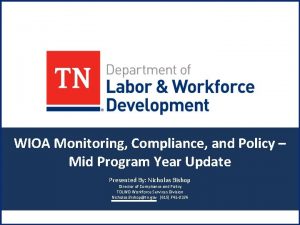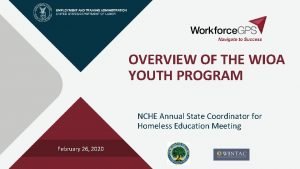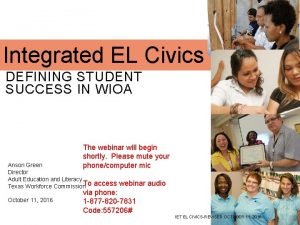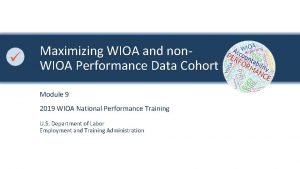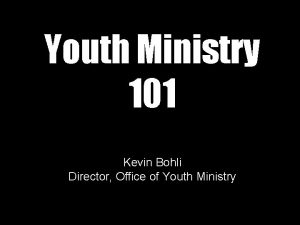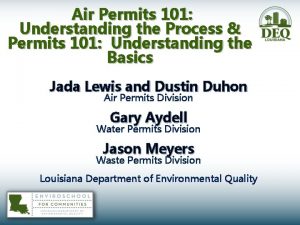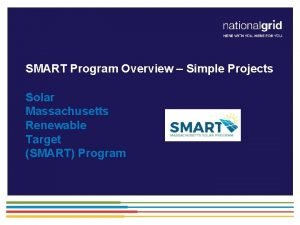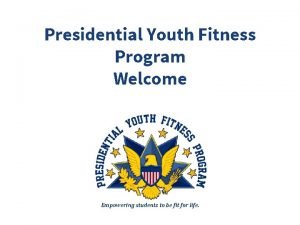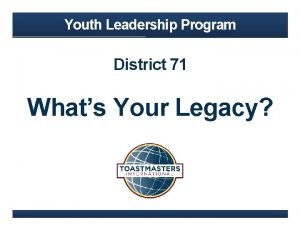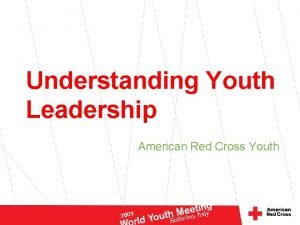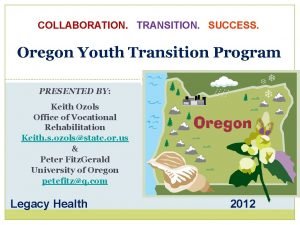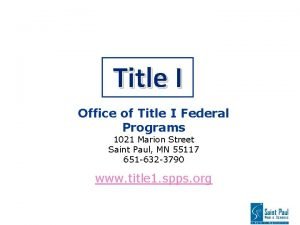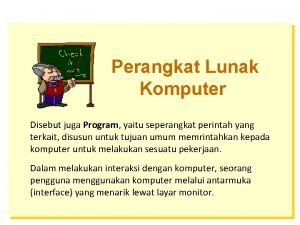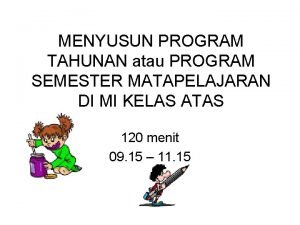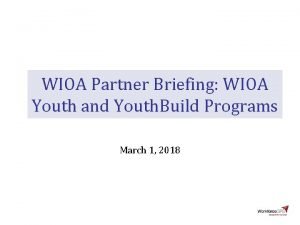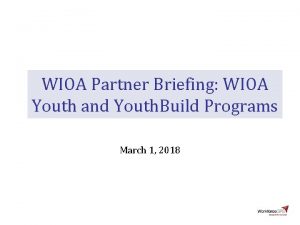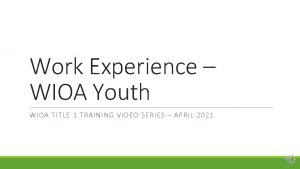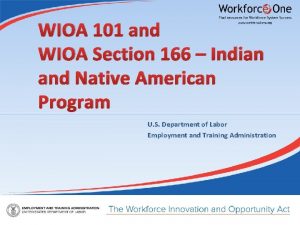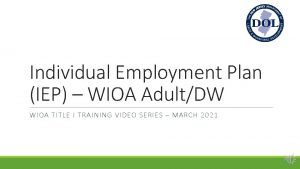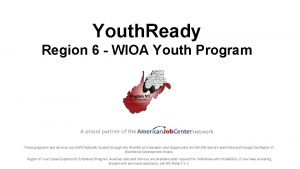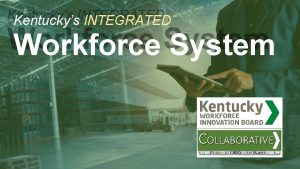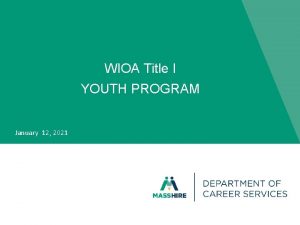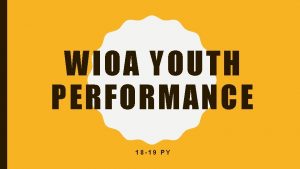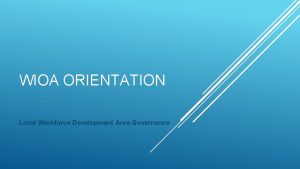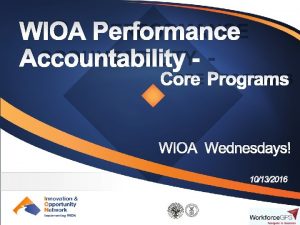WIOA Title I Youth Program 101 An Overview























- Slides: 23

WIOA Title I Youth Program 101: An Overview for Partners

Workforce Innovation and Opportunity Act • Signed into law on July 22, 2014 • First major reform of the public workforce system in 15 years • Designed to help job seekers access employment, education, training, and support services to succeed in the labor market • Match employers with the skilled workers they need to compete in the global economy • Four Titles authorizing 6 core programs

WIOA Core Programs • TITLE I: Adult, Dislocated Worker, and Youth programs • TITLE II: Adult Education and Literacy programs • TITLE III: Wagner-Peyser Employment Service • TITLE IV: Rehabilitation Act programs

WIOA: A Broad Youth Vision • An integrated service delivery system • High-quality services for youth and young adults • career exploration and guidance • continued support for educational attainment • opportunities for skills training in in-demand industries and occupations • culminating with a good job along a career pathway, enrollment in post-secondary education, or a Registered Apprenticeship

WIOA in Colorado • 10 local workforce areas • • • Adams Arapahoe/Douglas Boulder Denver El Paso/Teller Larimer Mesa Rural Consortium (52 rural Colorado counties) Tri-County (Jefferson, Clear Creek, and Gilpin) Weld • Each governed by a Local Workforce Development Board (at least 51% private business) • Some LWDBs have Youth Standing Committees

Colorado Title I Youth Funding WIOA Youth PY 15 PY 16 Difference % Change $10, 651, 527 $9, 505, 469 ($1, 146, 058) -10. 76%

The Basics of the Youth Program • Eligibility • Program Design Framework • Required Program Elements • Performance Indicators

WIOA Title I Youth Eligibility • Out-of-School Youth (Minimum 75% of funds) • Not attending any school; and • Not younger than 16 or older than age 24 at time of enrollment; and • One or more of the following:

Out-of-School Eligibility (cont. ) • One or more of the following: (1) A school dropout; (2) A youth who is within the age of compulsory school attendance, but has not attended school for at least the most recent complete school year calendar quarter (3) A recipient of a secondary school diploma or its recognized equivalent who is a low-income individual and is either basic skills deficient or an English language learner; (4) An individual who is subject to the juvenile or adult justice system; (5) A homeless individual, a runaway; (6)an individual who is in foster care or has aged out of the foster care system; (7) An individual who is pregnant or parenting; (8) An individual with a disability; (9) A low-income individual who requires additional assistance to enter or complete an educational program or to secure or hold employment

WIOA Title I Youth Eligibility • In-School Youth (Maximum 25% of funds) • Attending school; and • Not younger than 14 or older than age 21 at time of enrollment; and • Low Income; and • One or more of the following:

In-School Eligibility (cont. ) One or more of the following: (1) Basic skills deficient; (2) An English language learner; (3) An offender; (4) A homeless individual, a homeless child or youth, a runaway, (5) in foster care or has aged out of the foster care system, (6) An individual who is pregnant or parenting; (7) An individual with a disability; (8) An individual who requires additional assistance to complete an educational program or to secure or hold employment.

Program Design Framework • Eligibility determination; • Objective assessment; • Individual service strategy; and • Participation in one or more of the 14 WIOA youth program elements; and • Case management, including follow-up services

Objective Assessment • A review of: • Academic and occupational skill levels • Service needs • Strengths • For the purpose of identifying appropriate services and career pathways and informing the individual service strategy

Individual Service Strategy • identifies career pathways that include education and employment goals • considers career planning and the results of the objective assessment • prescribes achievement objectives and services • directly linked to one or more indicators of performance

Program Elements • Local programs must make all 14 program elements available to youth • Local programs determine which elements a youth receives based on the assessment and ISS • A program doesn’t need to provide every service to each participant

Program Elements • Local programs should partner with entities that can provide program elements at no cost • Do not need to spend WIOA youth funds on every program element, can leverage resources to provide some elements without using WIOA youth funds • Must have agreement with partners to provide leveraged elements

14 Program Elements 1) Tutoring, study skills training, instruction and evidence-based dropout prevention and recovery strategies that lead to completion of the requirements for a secondary school diploma or its recognized or for a recognized postsecondary credential; 2) Alternative secondary school services, or dropout recovery services, as appropriate; 3) Paid and unpaid work experiences that have academic and occupational education as a component of the work experience, which may include the following types of work experiences: (i) Summer employment opportunities and other employment opportunities available throughout the school year; (ii) Pre-apprenticeship programs; (iii) Internships and job shadowing; and (iv) On-the-job training opportunities;

14 Program Elements 4) Occupational skill training, which includes priority consideration for training programs that lead to recognized postsecondary credentials that align with in-demand industry sectors or occupations in the local area involved; 5) Education offered concurrently with and in the same context as workforce preparation activities and training for a specific occupation or occupational cluster; 6) Leadership development opportunities, including community service and peer-centered activities encouraging responsibility and other positive social and civic behaviors; 7) Supportive services 8) Adult mentoring for a duration of at least 12 months, that may occur both during and after program participation; 9) Follow-up services for not less than 12 months after the completion of participation;

14 Program Elements 10) Comprehensive guidance and counseling, which may include drug and alcohol abuse counseling, as well as referrals to counseling, as appropriate to the needs of the individual youth; 11) Financial literacy education; 12) Entrepreneurial skills training; 13) Services that provide labor market and employment information about in-demand industry sectors or occupations available in the local area, such as career awareness, career counseling, and career exploration services; and 14) Activities that help youth prepare for and transition to postsecondary education and training.

Performance Indicators 1. Percentage of program participants who are in education or training activities, or in unsubsidized employment during second quarter after exit 2. Percentage of participants who are in education or training activities or in unsubsidized employment during fourth quarter after exit 3. Median earnings of participants in unsubsidized employment during second quarter after exit

Performance Indicators (cont. ) 4. Percentage of participants who obtain a recognized post-secondary credential, secondary school diploma or equivalent during participation or within 1 year after program exit 5. Percentage of participants during a program year in education that leads to a recognized postsecondary credential or employment and who are achieving measurable gains towards those goals

Questions?

Contact Information: Robert Hanni 303 -318 -8815 rob. hanni@state. co. us Ronnie Lewis 303 -318 -8823 ronnie. lewis@state. co. us
 Wioa youth program elements
Wioa youth program elements Wioa
Wioa Wioa
Wioa Wioa
Wioa Wioa optimized system
Wioa optimized system Wioa maryland
Wioa maryland Youth ministry 101
Youth ministry 101 Understanding air permits
Understanding air permits Title fly and title page
Title fly and title page Title title
Title title Sbic program overview
Sbic program overview Ntep organogram
Ntep organogram Solar massachusetts renewable target (smart) program
Solar massachusetts renewable target (smart) program Presidential youth fitness program
Presidential youth fitness program Toastmasters youth leadership program certificate
Toastmasters youth leadership program certificate Red cross youth
Red cross youth Oregon youth transition program
Oregon youth transition program Proof of concept project management
Proof of concept project management Title one program
Title one program Sequential program and an event-driven program?
Sequential program and an event-driven program? Perangkat lunak computer disebut juga
Perangkat lunak computer disebut juga Program tahunan adalah
Program tahunan adalah Microsoft excel merupakan program aplikasi?
Microsoft excel merupakan program aplikasi? Microsoft excel merupakan perangkat lunak buatan
Microsoft excel merupakan perangkat lunak buatan

